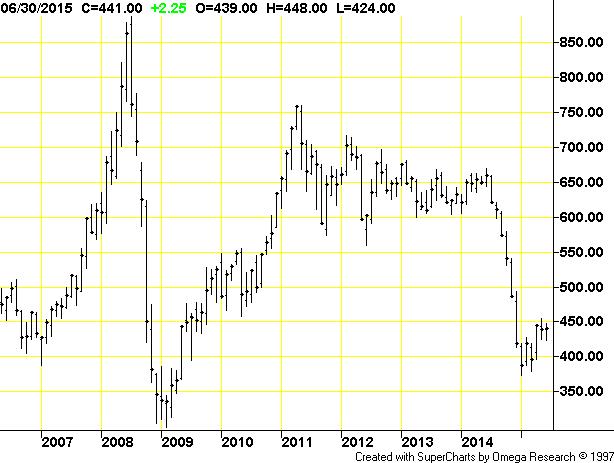By Sase Singh in Washington, DC
GOLD prices are getting squashed, rice and sugar price are not looking particularly good these days and oil prices have just entered a bear market. So are our main traded commodities in the doghouse? What roles are a weakening Chinese economy and a stronger US dollar playing in this new environment?
The experts believe that the days of great commodity prices for raw material is not dead but on death row. But they have said that before only to see the prices rebound. However, all indicators supports that the next 12 months will be commodities bear market. A bear market in this sense is defined as one in which prices of raw materials are falling.
As one of the leading commodities indices, the Goldman Sachs Commodity Index (GSCI) illustrates that the basket of commodities that it tracks, is now back at the level of 2009, when the world experienced one of its worst bear market.
(See graph below)
Goldman Sachs Commodity Index (GSCI)

The most favourable outcome for Guyana would have been the emergence of a new economic giant similar to China, which was using their developmental model when they were having a bull run in the year 2000 (substantial demand for raw materials). But such a model creates a false sense of security since it rewards our status as a raw material producer which directly contributes to our long-term stagnation.
The world’s economy continues to change and all the usual contenders who can effectively replace China in whole or in part on the world trade scene are either in some level of economic stress or are taking a different developmental path.
I speak of Brazil, Russia, India and South Africa in particular. The new world market now puts a premium on value added materials from source countries and a heavy penalty on raw material producers. The new world want more alumina rather than raw bauxite, more rice cereal rather than raw rice, refined sugar rather than raw sugar, fine jewellery rather than raw gold, wash, packed, processed and certified fresh foods and juices and so on. This is where Guyana has to be situated over the next 10 years. It is a process but it has to start today. And we can get there, but we need a plan.
The USDA just announced on July 22, 2015 that the world market price for milled rice when converted to metric tonnes was $305 per MT.
Guyana secured an average price of some US$445 per MT in 2014 but that is expected to decline significantly in 2016 as the Venezuelans reduce their imports from Guyana at a price that was clearly unsustainable.
This is more evidence that the price trajectories are all against Guyana with its subsistence forms of raw material production. The previous Jagdeo/Ramotar administration should never be forgiven for bungling almost every attempt at positioning Guyana on the value added chain. For them, personal greed was more important than national need. One only has to look at how the Skeldon Modernisation Project was ruined as a result of personal greed. Skeldon Estate is now is the millstone around the neck of the sugar industry. From as far back as 2011, most of the indicators concluded that “world supply is overwhelming demand and a calming of the Chinese economy was coming”. A calm Chinese economy means less appetite for raw materials. But the previous Jagdeo/Ramotar Administration continued to walk the same road not ever planning for the potholes in the road ahead.
This new Granger/Nagamootoo Government inherited several potholes brought forward from the Ramotar Administration and these facts must be brought to the attention of the Guyanese people. In this regard, I am disappointed in the fact that GINA has not risen to the challenge of explaining why our economic industries are where they are and what the Government is doing about it to move it out of the rut. Many are looking for details on the public policies going forward.
Based on the forecast, it will take several years for demand to catch up with supply and thus the next 3 years will be critical for Guyana. The people have to be more effectively engaged, a new development model rolled out and the public policies explained to the people. The honeymoon is now over!
Time to rebrand and reconfigure Go-Invest and construct a highly skilled team at that agency that is tasked with the primary objectives of getting the investors to the table who are interested in adding all sorts of value to our raw material production and transforming those discussion into bankable and active investable projects. Full support from the highest levels of Government is essential for this model to work since the Directors and Senior Managers of Go-Invest has to think, act and operate like businessmen, not bureaucrats. I am deeply disappointed that a world class industrialist like Dr Yesu Persaud could not find a place on that Board.
GOLD IS NOT GLITTERING SO MUCH ANY MORE
As gold loses its glitter on the world market, production locally continues to slide with the figures released to the end of June reflecting that gold production was 165,976 ounces in 2015 compared to 198,046 ounces in 2014.
Production in 2015 is not expected to surpass 365,000 ounces, which would be the worst production since 2011. Even with large-scale miners like Troy Resources Ltd and Guyana Goldfields Inc. coming on board, this is not expected to materially impact production for 2015 but would positively add to the 2016 figures. The prognosis: 2015 will be a gap year for the gold industry with the gold industry picking up steeply in 2016.
In June 2014, the Guyana Gold Board issued a statement saying that they are bullish about the recovery of the gold prices. Well that was all “hocus-pocus” since the world is in a bear market for the next 12 months; meaning prices will slide even further. All the indicators are advising that gold is heading for “sub-1000 dollar” prices soon.
The Chinese in July 2015 revealed that they have only bought 600 tonnes of gold over the last 6 years and will be buying incrementally lesser amounts over the next 2 years. When one compares this to the previous decade between 2001 and 2010, the Chinese bought as much as four times this amount to add to their reserves. The message is clear – demand for gold is soft and prices will continue to decline over the next year.
Gold Prices – 25 years
This means that the Gold Board cannot continue to buy gold at a high price and then sell it below that price internationally a few weeks later; that is financial insanity. The gold board should actively low-ball on prices going forward, even under the threat of miners wanting to sell gold on a secondary market. Let them!
Let the miners sell their production to the private traders to protect the solvency of the Gold Board’s trading book.
This situation actually strengthens the case of the Gold Board to advise that a downward price adjuster will be applied today, in order to compensate for future declines in the prices – meaning the Gold Board should offer to buy gold slightly cheaper than the world market prices with the principle aim of protecting the trading book of the State as the price continues to slide.
We must remind ourselves that the Gold Board stands to lose some Gy$4.8 billion if it only attempt to sell the gold that was bought under the Ramotar Government and still in its inventory.
It would therefore be unfair to the other taxpayers to allow any Government to put more billions of their money at risk. The only realistic strategy for these gold bars is to add them to the national gold reserves.
CONCLUSION
In the world we have seen a classic investment boom in raw commodities since 2000 to meet the needs of the unquenchable thirst of the Chinese economy. Unfortunately, after the mini-crash of 2009, that acceleration of supply was met with a cooling down of the Chinese economy and a more strategic and sensible style of consumerism in Europe and North America.
The strategy going forward is to be logical, not tautological.
Next time I shall be continuing our conversation by sharing my views on the Expansion Works on the Cheddi Jagan Airport.
(Persons wishing to comment/respond to this columnist can do so via email: sasesin1@yahoo.com)




.png)











